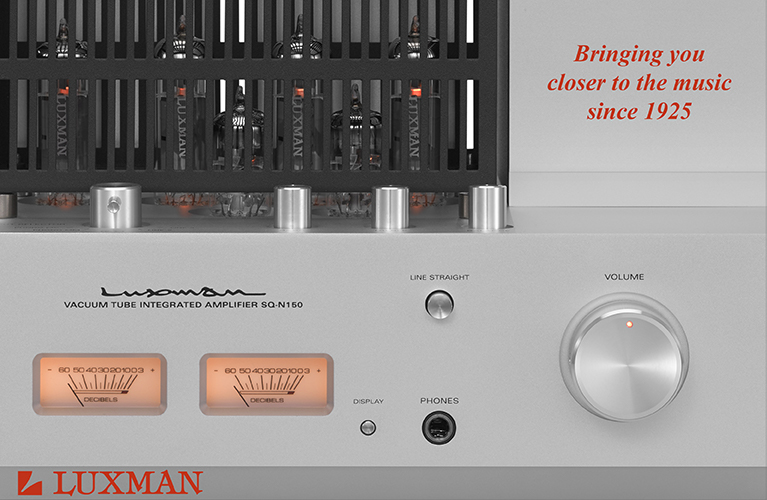Note: Measurements taken in the anechoic chamber at Canada's National Research Council can be found through this link.
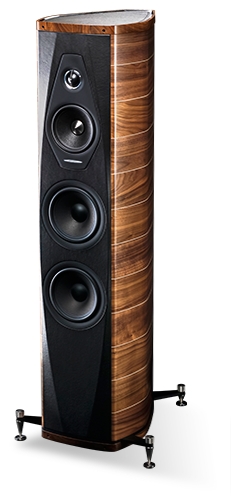
 Until just a few years ago, I never thought Sonus Faber’s speakers were all that special. While I could admire the woodwork of many of the older models, and quite liked some of their unique design elements -- those string grilles -- I never found any of the speakers’ overall styling to my liking. Nor did I like their sound, which I found inconsistent from model to model -- and no Sonus Faber model I heard sounded as close to neutral and natural as I like.
Until just a few years ago, I never thought Sonus Faber’s speakers were all that special. While I could admire the woodwork of many of the older models, and quite liked some of their unique design elements -- those string grilles -- I never found any of the speakers’ overall styling to my liking. Nor did I like their sound, which I found inconsistent from model to model -- and no Sonus Faber model I heard sounded as close to neutral and natural as I like.
Then, things changed. In 2010, the company’s CEO, Mauro Grange, hired industrial designer Livio Cucuzza to partner with acoustic designer Paolo Tezzon, who’d already been there a few years. Together, Tezzon and Cucuzza are the loudspeaker equivalent of Lennon and McCartney -- and in 2011, Sonus Faber released their first joint design, the floorstanding Amati Futura. Sexy isn’t a word I normally use for loudspeakers, but it describes that model. The Amati Futura’s mix of wood and metal looked staggeringly hot -- and still does. And to my ears, it sounded a helluva lot more natural than had the Sonus Fabers before it. Not long after came the Guarneri Evolution, which looks like the Futura in a stand-mount design. Then came Sonus Faber’s current top model, the jaw-droppingly gorgeous Aida. Its looks make it a supercar among superspeakers, with aesthetic similarities to the Amati Futura and Guarneri Evolution, but with new design elements that have since appeared in some of the speakers that followed -- including the Olympica models, which cost less than any of the speakers I’ve mentioned.
The Olympica line of main speakers includes the stand-mounted Olympica I ($6500 USD/pair; stands, add $1200/pair) and two floorstanders: the Olympica II ($10,000/pair) and the subject of this review, the Olympica III ($13,500/pair). If you want to flesh out a home-theater system, there’s also the Olympica Center ($5500). I listened to the Olympica IIIs as a stereo pair.
Description
The Olympica III is a three-way, four-driver design with a beautifully finished cabinet whose curved sides form, as in the Aida, a lyre-shaped cross section. The Olympica III’s main cabinet measures 42.5”H x 10.5”W x 16.5”D; but on its base with metal outriggers (this comes already attached), and with the chromed floor spikes screwed in, the overall dimensions are 43.5”H x 15.7”W x 19.8”D. The speaker is big enough to look substantial, but not so big that it overpowers a room. It’s sized just right.
The drivers comprise a silk-dome tweeter with a diaphragm that measures just over 1” (29mm) in diameter; a single midrange driver with a 5.9”-diameter cone that Sonus Faber says is made of cellulose pulp, kapok, kenaf, and “other natural fibers”; and two woofers wired in parallel, each with a 7” cone made of “hi-tech rigid syntactic foam with external layers in treated cellulose pulp.” All drivers are unique to Sonus Faber.
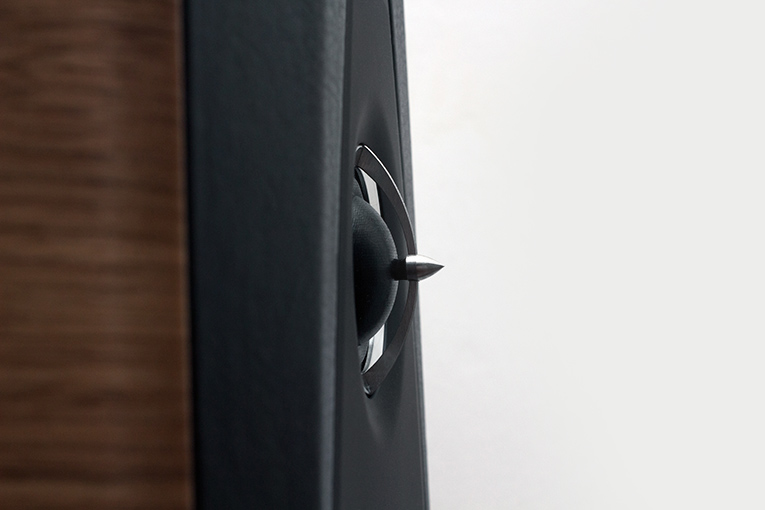
The tweeter is what Sonus Faber calls its “Arrow Point” Damped Apex Dome (DAD), for the pointed piece of metal that juts forward. This tweeter design, introduced in the Aida, is also seen in SF’s newest speaker, the Lilium. As the tweeter’s full name suggests, the “Arrow Point” DAD has a damping pad between the pointy piece and the dome that holds the center in place, while leaving the rest of the diaphragm free to move around it. The idea is to prevent some of the natural breakup modes of a silk dome that occur within the audioband, and which can be so strong that sometimes the center of the dome ends up in opposite phase to the area around it. The DAD’s downside is that it compromises the speaker’s off-axis performance at higher frequencies; the designer must carefully tailor the speaker’s frequency response, on and off axis, to achieve a correct overall tonal balance for a room.
The woofers are crossed over to the midrange at 250Hz, and the midrange to the tweeter at 2.5kHz, using Sonus Faber’s “Paracross topology,” which Paolo Tezzon explained to me when I visited the factory last year. Basically, the first part of the crossover uses shallow slopes to maintain close to optimal phase integrity; then, after the drivers are brought down in level enough, steeper slopes are used to more quickly curtail their responses, so they’re not operating outside their desirable ranges. Sonus Faber claims for the Olympica III a sensitivity of 90dB/2.83V/m, which is higher than average, but an impedance of 4 ohms, which is lower than average -- an amp with good current capability will be needed. The specified frequency response is 35Hz-30kHz, which includes the port’s output.
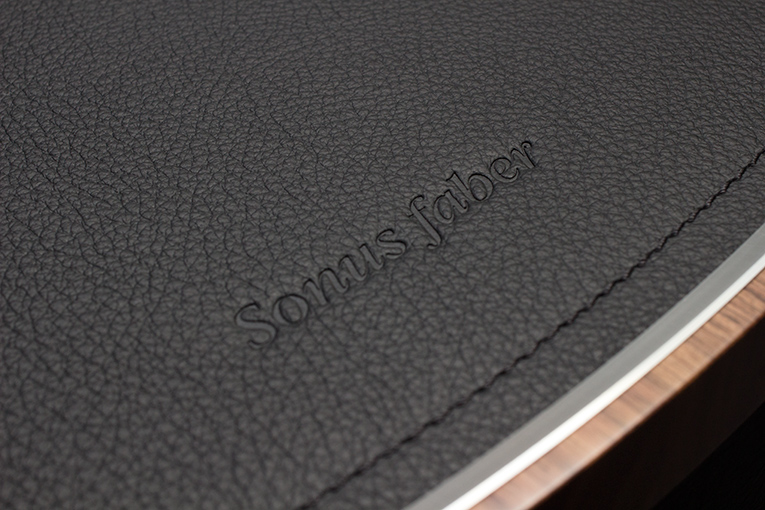
The cabinet’s front, side, and rear walls are made primarily of MDF; the top and bottom pieces, in the edges of which are holes for the grille, are of solid walnut. The finishwork also includes leather, a hallmark of Sonus designs since long before Cucuzza and Tezzon came along. On the Olympica III, the leather is on the front, rear, and, uniquely, top, where it’s slightly below the level of the rim, stamped with the Sonus Faber logo, stitched along the sides, and finished around its perimeter with metal trim. During my visit, I asked Livio Cucuzza about his decision to cover the top panel with leather. Because that’s where the owner’s hand will most often touch the speaker, he said, he wanted that touch to give a feeling of quality -- not only for the way it feels, but for the scent of leather it leaves on the fingers. I also found the soft, durable, nonslip surface of the leather perfect for my reading glasses, smartphone, and, occasionally, car keys -- all of which I placed there with great care. I’m not sure even Cucuzza knew his leather patches would prove that handy.
Such attention to detail extends to the front and rear panels: Plastic faceplates surround the drivers to acoustically smooth the front baffle, while concealing the driver bolts for a clean appearance. Sonus Faber’s signature string grilles partially hide and protect the drivers. Two pairs of high-quality, extremely attractive binding posts are provided, for biamping or biwiring. Near the bottom of the rear panel and slightly inset, these are designed specifically for the Olympica series. (Cucuzza told me that every Sonus Faber line has posts specifically designed for it.) Finally, near the top of the rear panel and also slightly inset, is the serial-number plate. On most speakers, the provision and placement of this number seems almost an afterthought; it’s usually just stamped or even handwritten somewhere near the binding posts.
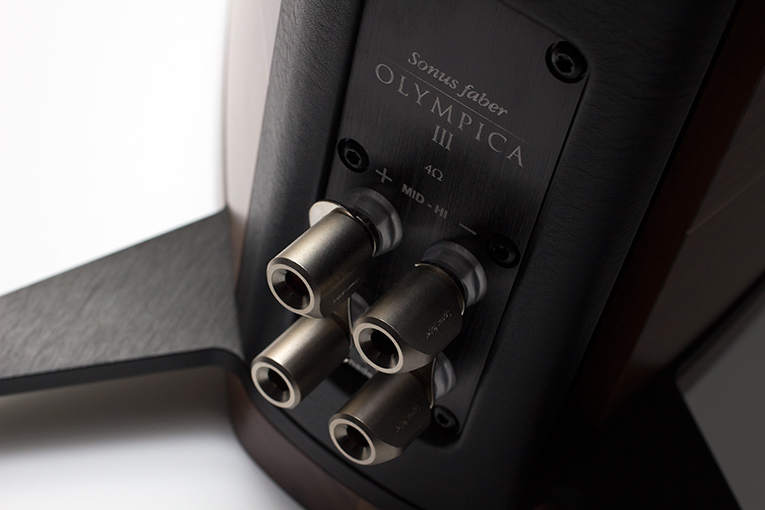
The Olympica III is bilaterally symmetrical when viewed from the front, but not from the rear. One sidewall connects directly to the rear panel; the other doesn’t, leaving a vertical slot that runs the height of the speaker and acts as a port, to supplement the bass response. Furthermore, there’s a short secondary wall that attaches to the rear panel and is difficult to see -- it goes inside the cabinet so that the slot isn’t just an opening, but a pathway through which air can travel. At the port’s output, attached to the secondary wall, is a thin, narrow strip of perforated metal that runs the height of the speaker and has two functions: to reduce noise as the air rushes out of the port (think of the dimples on a golf ball), and to add a touch of glamor to the backside. The ports are on opposing sides of each matched set of speakers, and whether to place the speakers so that the ports fire inward or outward will mostly depend on the acoustics of the room. In my room, the ports firing outward, away from each other, worked better.
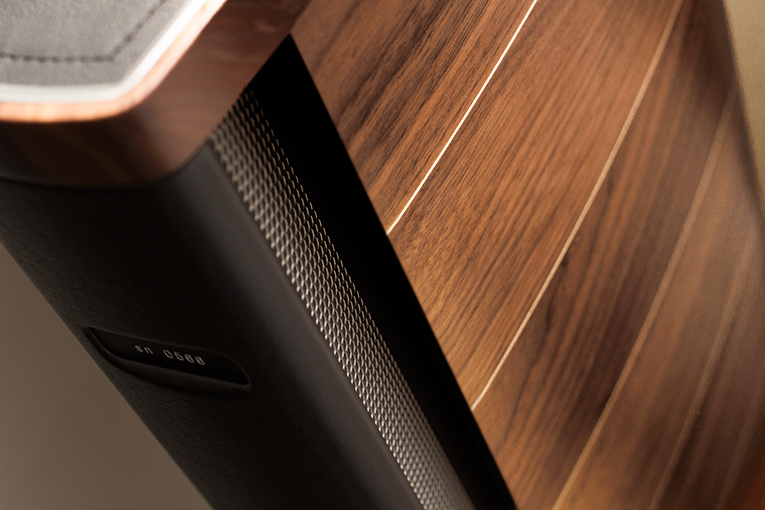
No description of the Olympica III would be complete without a mention of the veneer work, which is as unique as it is attractive. On each side of the speaker are 12 pieces of real-wood veneer, each about 3” wide, laid horizontally, from the front of the speaker to the back. Between each pair of these strips runs a very thin strip or doghe (slat). The quality of workmanship is superb, and the result, whether you get the Graphite finish or the lighter, natural-stained Walnut of my review samples, looks so spectacular that only full-size color images can accurately represent it. When I visited the factory, I wondered why the Italians are capable of woodworking so fine that it makes everything else look plain. Even after I’d lived with the Olympica IIIs a long time, I still wondered.
Sound
When I set up a pair of speakers, the first thing I listen for is their tonal balance. I could tell right away that the Olympica III was not a pinnacle of neutrality, like Magico’s S5 ($29,400/pair), which I reviewed a year ago; or Revel’s Ultima2 Salon2 ($21,998/pair), a pair of which I’ve had at my place for some time; or even Revel’s Performa3 F206 ($3500/pair), which I’ve just reviewed. But it wasn’t that far off. My ears told me that the Olympica III strayed from strict neutrality in the upper mids, but only by a bit, and in a pleasing way that resulted in a slightly relaxed sound that was less in-my-face than the Revels and Magico can be. Even with the most upfront and visceral power amp I drove them with, Hegel Music Systems’ H30, the Olympica IIIs’ slight laid-back quality was still apparent.
So while the Olympica III had a slight sonic signature, it still sounded “right” to me -- not like Sonus Fabers of yesteryear, whose colorations were serious enough that I found them neither palatable nor acceptable. Leonard Cohen’s deep, rich voice is miked ultra-closely on his Old Ideas (16-bit/44.1kHz FLAC, Columbia), and through the Revel Performa3 F206es it sounds right here. Through the Olympica IIIs, the meat of Cohen’s voice had just as much presence and immediacy, but with a subtly more relaxed quality -- as if he and the other musicians had taken a small step back on the stage. The laid-back upper mids were more noticeable on the brasher-, thinner-sounding Tell ’Em I’m Gone, from Yusuf, aka Cat Stevens (16/44.1 FLAC, Legacy). This album sounds more compressed than Cohen’s Old Ideas, with far more emphasis on the upper frequencies -- particularly in such tracks as “Gold Digger” and Procol Harum’s “The Devil Came from Kansas,” which sound a bit harsh -- but the Olympica III’s slight reticence in the upper mids made this subtly less obvious, and therefore more pleasing to the ears.
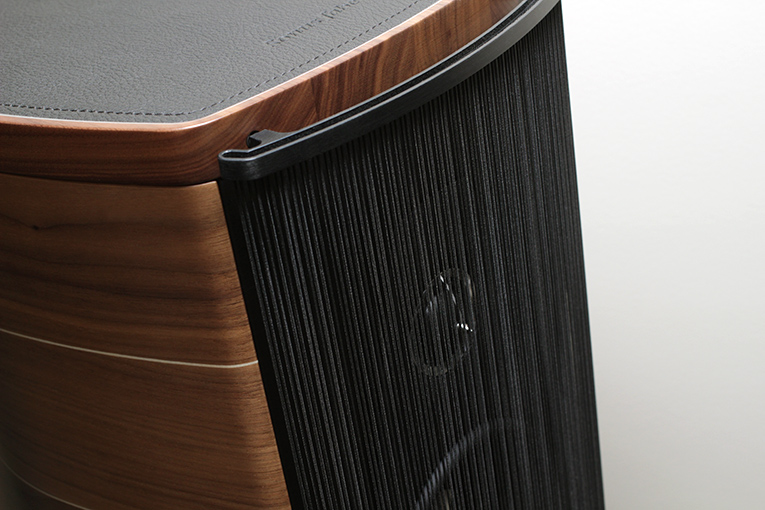
That slightly laid-back character also contributed to the overall soundstage depth: the stage didn’t begin at the plane defined by the speakers’ baffles but slightly behind it, and extended farther to the rear than with more upfront-sounding speakers. Yet that slightly distant characteristic didn’t sacrifice image solidity -- in that regard, the Olympica IIIs’ highly focused images equaled those produced in my room by the Magico S5s, Revel Salon2s, and Revel F206es.
While slightly relaxed in the upper mids, and with a silky smoothness through the midband that made women’s voices sound insanely good -- I’m not sure I’ve heard k.d. lang’s voice in Leonard Cohen’s “Hallelujah,” from her Hymns of the 49th Parallel (16/44.1 FLAC, Nonesuch), sound more seductive -- the Olympica III was definitely not lacking for detail. In fact, the Olympica’s resolution in my system approached that of both Revels and the Magico S5, and let me hear minute details in my favorite recordings -- as well as the incredibly spacious soundstages that the outstanding Luxman C-900u preamp and M-900u power amp produced when I reviewed them. (In that regard, the Luxmans are nothing short of reference class.) In a nutshell, the Olympica’s slightly relaxed sound could still reveal detail.
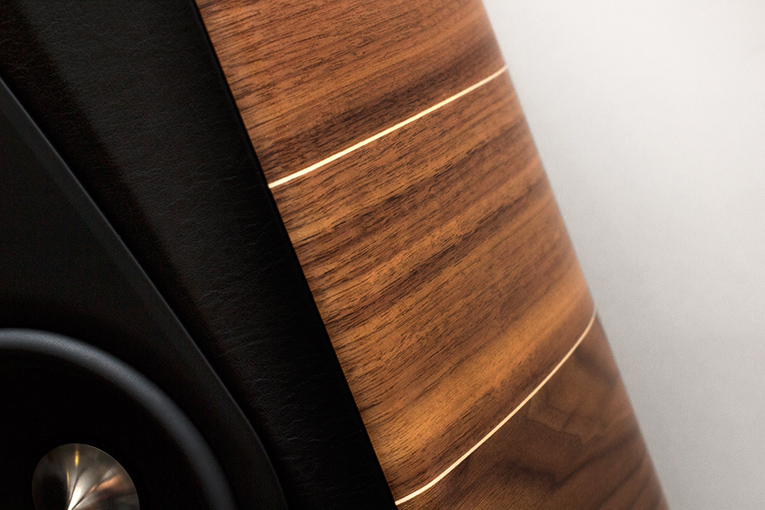
But the Olympica III’s highs were anything but relaxed or subdued -- lively, spirited, even exciting at times, that “Arrow Point” soft-dome tweeter impressed me with how cleanly and effortlessly it sounded without ever being too bright. Cymbals shimmered and guitars shone but were never edgy or metallic, as they often can be through metal domes -- even some of the new beryllium models. To my ears, no beryllium dome has sounded quite as sweet as the Olympica III’s silk dome. Obviously, Paolo Tezzon has gotten its voicing right.
At the other end of the audioband I heard prodigious bass output, which surprised me -- I wasn’t expecting much bass, given the Olympica III’s smallish woofers and modest cabinet size. The first time I heard powerful output down to about 30Hz, I sat up and took notice -- that was as deep as the Magico S5 had gone in my room at more than twice the price. That kind of extension is nothing to sneeze at. The Olympica IIIs also sounded weightier in the lower end than the S5s, if not quite as detailed. The Sonus Fabers could hammer out the weight of a kick drum or the bottom end of a piano as if there were no tomorrow -- the robust sound of Ola Gjeillo’s concert grand on his Stone Rose (16/44.1 FLAC, 2L) was thrilling to hear, so fulsomely realistic it was.
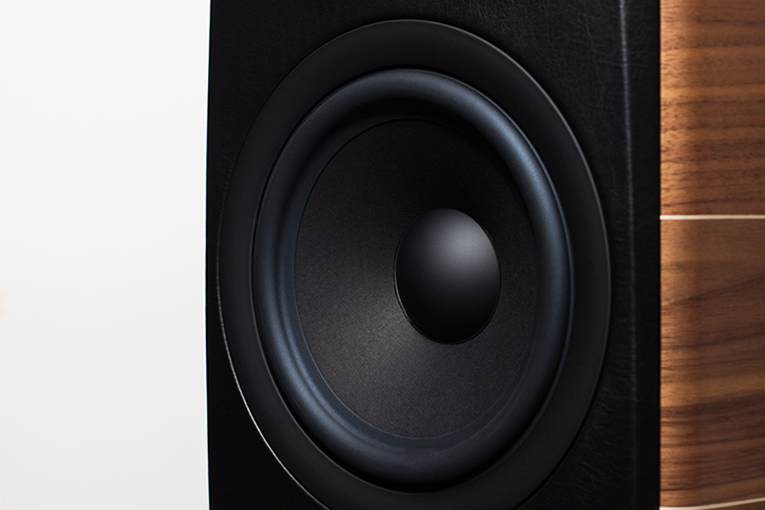
This low-end heft had at first forced me to adjust the speakers’ positions a bit, so that the lower end didn’t overpower the mids -- the IIIs’ sound was that full down low. But once I had them dialed in, it was bliss -- a natural-sounding tonal balance with excellent extension at both ends of the audioband. If there’s a downside to the Olympica’s bass, it’s would be that it’s powerful enough to possibly overload a smaller room. If that happens, some fine-tuning of speaker positions may be required, including swapping the speakers’ positions, to see which works better: ports firing toward or away from each other. Or it might be necessary to scale down to the Olympica II, which has only a single woofer.
Nor did I expect the Olympica IIIs to produce the kind of sound-pressure levels I demanded of them. Mostly this was because I assumed that so attractive speaker, with its fancy woodwork, beautiful styling, and cosmetic embellishments, would be a delicate flower. I shouldn’t make such assumptions. The Olympicas could get down and party hard when I wanted them to -- they played “You Shook Me All Night Long,” from AC/DC’s Back in Black (16/44.1 FLAC, Atlantic), at 11, without crying uncle. Likewise, I’ve found that Lindsey Buckingham’s soaring guitar in “Go Your Own Way,” from Fleetwood Mac’s Rumours (24/96 FLAC, Warner Bros.), can sound seriously constrained if a speaker can’t play loudly and dynamically enough. The Olympica IIIs rendered this track cleanly and effortlessly at volume levels I considered beyond the levels of “acceptable” -- my ears began to ring. Without question, this beautiful-looking Italian speaker ha le palle (has balls).
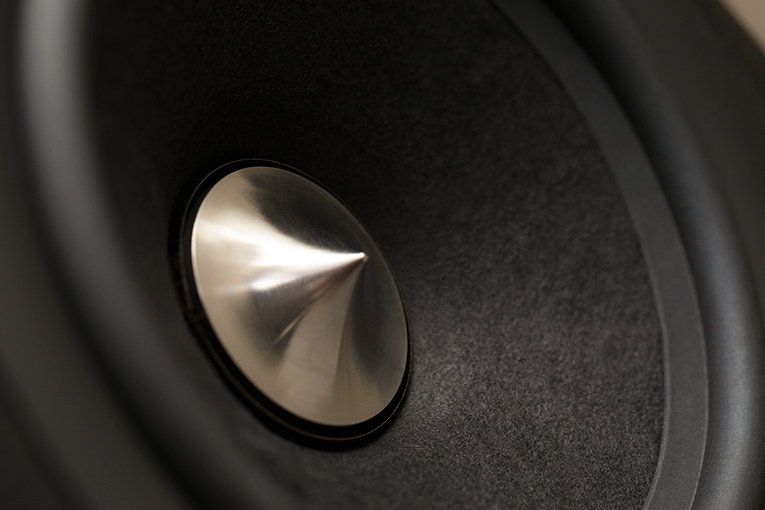
The Olympica IIIs could sound just as enchanting at listening levels far below normal. This is becoming increasingly important to me -- these days, I tend to listen to music at low levels as often as at high. When I played the Sonus Fabers quietly enough that my children’s talking could overpower the sound, their ample bass, spirited highs, and smooth, detailed mids were every bit as convincing as when I ramped things up. And the soundstage was just as wide and deep as when the volume came up to more realistic levels. If you’re not in the habit of playing music at insane levels, you’ll need a current-strong amp to fully control the Olympica IIIs -- but you won’t necessarily need one that can deliver hundreds of watts. All in all, I found the Olympica III a very versatile speaker that could skillfully reproduce recordings of any type of music at almost any volume level, from whisper-quiet to ear-ringingly loud.
Conclusions
Given my previous experience of Sonus Faber loudspeakers, it was intriguing to review the Olympica III. The earmarks of Sonus Faber speakers past are obvious: lavish woodwork, leather accents, string grilles, etc. But I could also see improvements in styling, and commensurate improvements in sound. That sound is still very distinctive -- there’s a sonic signature there, but one that’s far more natural and uncolored than the Sonus Fabers of yesteryear. Although my tastes lean toward strict neutrality, I not only greatly enjoyed how the Olympica III has been voiced, I loved the way it sounded overall. In my book, Sonus Faber is doing something very right.
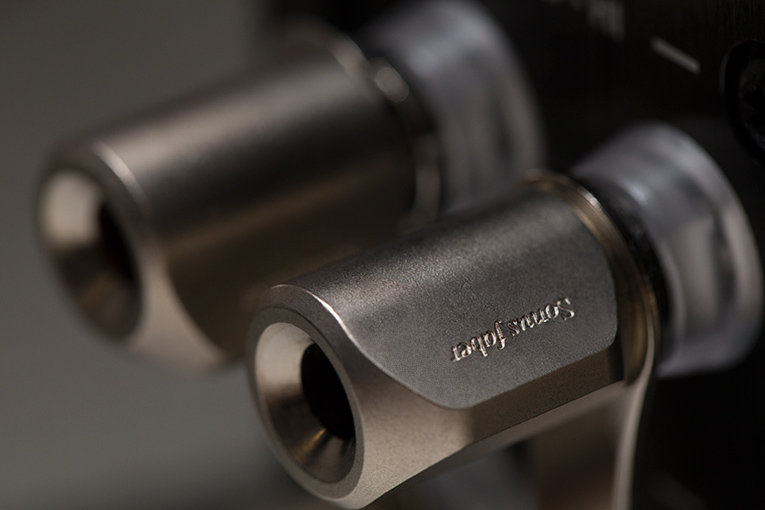
I believe that the Olympica III is an example of exactly what Sonus Faber stands for today: Italian-flavored build quality and styling combined with a signature sound that audiophiles the world over can appreciate. That combination could prove lethal to their competitors -- while I could name a half-dozen brands off the top of my head that make good-sounding speakers at similar prices, none looks as if it’s worth a damn placed side by side with the Olympica III. With almost all of them, it’s like parking a Ford next to a Ferrari. For those who want a speaker that thrills the eyes as much as the ears, Sonus Faber’s Olympica III gets my highest recommendation.
. . . Doug Schneider
das@soundstagenetwork.com
Associated Equipment
- Speakers -- Revel Performa3 F206 and Ultima2 Salon2
- Preamplifiers -- EMM Labs PRE2, Luxman C-900u, Simaudio Moon Evolution 740P
- Amplifiers -- Hegel Music Systems H30, Luxman M-900u, Simaudio Moon Evolution 870A
- Digital-to-analog converters -- EMM Labs DAC2X, Simaudio Moon Evolution 650D
- Computer -- Samsung laptop running Windows 7 and JRiver Media Center 18
- Digital interconnects -- AudioQuest Carbon USB
- Analog interconnects -- Crystal Cable CrystalConnect Standard Diamond
- Speaker cables -- Siltech Classic Anniversary 330L
Sonus Faber Olympica III Loudspeakers
Price: $13,500 USD per pair.
Warranty: Three years parts and labor.
Sonus Faber SPA
Via Antonia Meucci 10
36057 Arcugnano (VI)
Italy
Phone: (39) 0444-288788
Website: www.sonusfaber.com






















